Label-Free Biosensor Using a Silver Specific RNA-Cleaving DNAzyme Functionalized Single-Walled Carbon Nanotube for Silver Ion Determination
Abstract
:1. Introduction
2. Materials and Methods
2.1. Chemicals and Materials
2.2. Apparatus
2.3. Fabrication of SWNTs-FET
2.4. Immobilization
2.5. Sensing Protocol
3. Results
3.1. Characterization
3.2. Optimization
3.3. Analytical Performance
3.4. Interference
3.5. Real Sample Analysis
4. Conclusions
Supplementary Materials
Acknowledgments
Author Contributions
Conflicts of Interest
References
- Chabukdhara, M.; Munjal, A.; Nema, A.K.; Gupta, S.K.; Kaushal, R.K. Heavy metal contamination in vegetables grown around peri-urban and urban-industrial clusters in Ghaziabad, India. Hum. Ecol. Risk Assess. Int. J. 2016, 22, 736–752. [Google Scholar] [CrossRef]
- Ciszewski, D.; Grygar, T.M. A review of flood-related storage and remobilization of heavy metal pollutants in river systems. Water Air Soil Pollut. 2016, 227, 1–19. [Google Scholar] [CrossRef] [PubMed]
- Zhuang, P.; Zou, B.; Li, N.; Li, Z. Heavy metal contamination in soils and food crops around Dabaoshan mine in Guangdong, China: Implication for human health. Environ. Geochem. Health 2009, 31, 707–715. [Google Scholar] [CrossRef] [PubMed]
- Fu, J.; Zhou, Q.; Liu, J.; Liu, W.; Wang, T.; Zhang, Q.; Jiang, G. High levels of heavy metals in rice (Oryzasativa L.) from a typical E-waste recycling area in southeast China and its potential risk to human health. Chemosphere 2008, 71, 1269–1275. [Google Scholar] [CrossRef] [PubMed]
- Ratte, H.T. Bioaccumulation and toxicity of silver compounds: A review. Environ. Toxicol. Chem. 1999, 18, 89–108. [Google Scholar] [CrossRef]
- Costa, V. The deterioration of silver alloys and some aspects of their conservation. Stud. Conserv. 2001, 46, 18–34. [Google Scholar] [CrossRef]
- Yang, W.; Shen, C.; Ji, Q.; An, H.; Wang, J.; Liu, Q.; Zhang, Z. Food storage material silver nanoparticles interfere with DNA replication fidelity and bind with DNA. Nanotechnology 2009, 20, 085102. [Google Scholar] [CrossRef] [PubMed]
- Fung, M.C.; Bowen, D.L. Silver products for medical indications: Risk-benefit assessment. J. Toxicol. Clin. Toxicol. 1996, 34, 119–126. [Google Scholar] [CrossRef] [PubMed]
- Blaser, S.A.; Scheringer, M.; MacLeod, M.; Hungerbühler, K. Estimation of cumulative aquatic exposure and risk due to silver: Contribution of nano-functionalized plastics and textiles. Sci. Total Environ. 2008, 390, 396–409. [Google Scholar] [CrossRef] [PubMed]
- Kampmann, Y.; De Clerck, E.; Kohn, S.; Patchala, D.; Langerock, R.; Kreyenschmidt, J. Study on the antimicrobial effect of silver-containing inner liners in refrigerators. J. Appl. Microbiol. 2008, 104, 1808–1814. [Google Scholar] [CrossRef] [PubMed]
- Chancerel, P.; Meskers, C.E.; Hagelüken, C.; Rotter, V.S. Assessment of precious metal flows during preprocessing of waste electrical and electronic equipment. J. Ind. Ecol. 2009, 13, 791–810. [Google Scholar] [CrossRef]
- Siblerud, R.L.; Motl, J.; Kienholz, E. Psychometric evidence that mercury from silver dental fillings may be an etiological factor in depression, excessive anger, and anxiety. Psychol. Rep. 1994, 74, 67–80. [Google Scholar] [CrossRef] [PubMed]
- Baker, C.; Pradhan, A.; Pakstis, L.; Pochan, D.J.; Shah, S.I. Synthesis and antibacterial properties of silver nanoparticles. J. Nanosci. Nanotechnol. 2005, 5, 244–249. [Google Scholar] [CrossRef] [PubMed]
- Leventer, H.; Teltsch, B. The contribution of silver carp (Hypophthalmichthys molitrix) to the biological control of Netofa reservoirs. Hydrobiologia 1990, 191, 47–55. [Google Scholar] [CrossRef]
- Wen, Y.; Xing, F.; He, S.; Song, S.; Wang, L.; Long, Y.; Li, D.; Fan, C. A graphene-based fluorescent nanoprobe for silver (I) ions detection by using graphene oxide and a silver-specific oligonucleotide. Chem. Commun. 2010, 46, 2596–2598. [Google Scholar] [CrossRef] [PubMed]
- Purcell, T.W.; Peters, J.J. Sources of silver in the environment. Environ. Toxicol. Chem. 1998, 17, 539–546. [Google Scholar] [CrossRef]
- Křížková, S.; Adam, V.; Kizek, R. Phytotoxicity of Silver Ions. Chem. Listy 2009, 103, 559–568. [Google Scholar]
- Bell, R.A.; Kramer, J.R. Structural chemistry and geochemistry of silver-sulfur compounds: Critical review. Environ. Toxicol. Chem. 1999, 18, 9–22. [Google Scholar]
- Klotz, I.M.; Urquhart, J.M.; Fiess, H.A. Interactions of metal ions with the sulfhydryl group of serum albumin. J. Am. Chem. Soc. 1952, 74, 5537–5538. [Google Scholar] [CrossRef]
- Drake, P.L.; Hazelwood, K.J. Exposure-related health effects of silver and silver compounds: A review. Ann. Occup. Hyg. 2005, 49, 575–585. [Google Scholar] [PubMed]
- Fisher, N.M.; Marsh, E.; Lazova, R. Scar-localized argyria secondary to silver sulfadiazine cream. J. Am. Acad. Dermatol. 2003, 49, 730–732. [Google Scholar] [CrossRef]
- Martin, S.; Griswold, W. Human health effects of heavy metals. Environ. Sci. Technol. Brief Citiz. 2009, 15, 1–6. [Google Scholar]
- Ghaedi, M.; Shokrollahi, A.; Niknam, K.; Niknam, E.; Najibi, A.; Soylak, M. Cloud point extraction and flame atomic absorption spectrometric determination of cadmium (II), lead (II), palladium (II) and silver (I) in environmental samples. J. Hazard. Mater. 2009, 168, 1022–1027. [Google Scholar] [CrossRef] [PubMed]
- Hosoba, M.; Oshita, K.; Katarina, R.K.; Takayanagi, T.; Oshima, M.; Motomizu, S. Synthesis of novel chitosan resin possessing histidine moiety and its application to the determination of trace silver by ICP-AES coupled with triplet automated-pretreatment system. Anal. Chim. Acta 2009, 639, 51–56. [Google Scholar] [CrossRef] [PubMed]
- Yuan, C.-G.; Wang, J.; Zhai, W.; Zhang, Y.; Zhang, Y.; Li, J.; Zhang, Q. Silver modified magnetic carbon nanotubes composite as a selective solid phase extractor for preconcentration and determination of trace mercury ions in water solution. Int. J. Environ. Anal. Chem. 2013, 93, 1513–1524. [Google Scholar] [CrossRef]
- Paramelle, D.; Sadovoy, A.; Gorelik, S.; Free, P.; Hobley, J.; Fernig, D.G. A rapid method to estimate the concentration of citrate capped silver nanoparticles from UV-visible light spectra. Analyst 2014, 139, 4855–4861. [Google Scholar] [CrossRef] [PubMed]
- Mitrano, D.M.; Barber, A.; Bednar, A.; Westerhoff, P.; Higgins, C.P.; Ranville, J.F. Silver nanoparticle characterization using single particle ICP-MS (SP-ICP-MS) and asymmetrical flow field flow fractionation ICP-MS (AF4-ICP-MS). J. Anal. Atom. Spectrom. 2012, 27, 1131–1142. [Google Scholar] [CrossRef]
- Wang, Z.-X.; Ding, S.-N. One-pot green synthesis of high quantum yield oxygen-doped, nitrogen-rich, photoluminescent polymer carbon nanoribbons as an effective fluorescent sensing platform for sensitive and selective detection of silver (I) and mercury (II) ions. Anal. Chem. 2014, 86, 7436–7445. [Google Scholar] [CrossRef] [PubMed]
- Man, B.Y.-W.; Chan, D.S.-H.; Yang, H.; Ang, S.-W.; Yang, F.; Yan, S.-C.; Ho, C.-M.; Wu, P.; Che, C.-M.; Leung, C.-H. A selective G-quadruplex-based luminescent switch-on probe for the detection of nanomolar silver (i) ions in aqueous solution. Chem. Commun. 2010, 46, 8534–8536. [Google Scholar] [CrossRef] [PubMed]
- Li, T.; Shi, L.; Wang, E.; Dong, S. Silver-Ion-Mediated DNAzyme Switch for the Ultrasensitive and Selective Colorimetric Detection of Aqueous Ag+ and Cysteine. Chem. Eur. J. 2009, 15, 3347–3350. [Google Scholar] [CrossRef] [PubMed]
- Bian, L.; Ji, X.; Hu, W. A novel single-labeled fluorescent oligonucleotide probe for silver (I) ion detection in water, drugs, and food. J. Agric. Food Chem. 2014, 62, 4870–4877. [Google Scholar] [CrossRef] [PubMed]
- Li, X.; Wu, Z.; Zhou, X.; Hu, J. Colorimetric response of peptide modified gold nanoparticles: An original assay for ultrasensitive silver detection. Biosens. Bioelectron. 2017, 92, 496–501. [Google Scholar] [CrossRef] [PubMed]
- Saran, R.; Liu, J. A silver DNAzyme. Anal. Chem. 2016, 88, 4014–4020. [Google Scholar] [CrossRef] [PubMed]
- Moraes, R.A.; Matos, C.F.; Castro, E.G.; Schreiner, W.H.; Oliveira, M.M.; Zarbin, A.J. The effect of different chemical treatments on the structure and stability of aqueous dispersion of iron-and iron oxide-filled multi-walled carbon nanotubes. J. Braz. Chem. Soc. 2011, 22, 2191–2201. [Google Scholar] [CrossRef]
- Shi, Y.; Ren, L.; Li, D.; Gao, H.; Yang, B. Optimization conditions for single-walled carbon nanotubes dispersion. J. Surf. Eng. Mater. Adv. Technol. 2013, 3, 6–12. [Google Scholar] [CrossRef]
- Prakash, R.; Superfine, R.; Washburn, S.; Falvo, M.R. Functionalization of carbon nanotubes with proteins and quantum dots in aqueous buffer solutions. Appl. Phys. Lett. 2006, 88, 063102. [Google Scholar] [CrossRef]
- Zhou, X.-H.; Kong, D.-M.; Shen, H.-X. Ag+ and cysteine quantitation based on G-quadruplex–hemin DNAzymes disruption by Ag+. Anal. Chem. 2009, 82, 789–793. [Google Scholar] [CrossRef] [PubMed]
- Chen, Y.; Mao, K.; Zhou, X.; Shen, A.; Hu, J. Simultaneous fluorescence detection of mercury (II) and silver ions based on rhodamine B isothiocyanate and 5-carboxyfluorescein-ssDNA modified probe. Wuhan Univ. J. Nat. Sci. 2016, 21, 499–504. [Google Scholar] [CrossRef]
- Pu, W.; Zhao, H.; Huang, C.; Wu, L.; Xua, D. Fluorescent detection of silver (I) and cysteine using SYBR Green I and a silver (I)-specific oligonucleotide. Microchim. Acta 2012, 177, 137–144. [Google Scholar] [CrossRef]
- Li, H.; Zhai, J.; Sun, X. Sensitive and selective detection of silver (I) ion in aqueous solution using carbon nanoparticles as a cheap, effective fluorescent sensing platform. Langmuir ACS J. Surf. Colloids 2011, 27, 4305–4308. [Google Scholar] [CrossRef] [PubMed]
- Zhu, G.; Li, Y.; Zhang, C.-Y. Simultaneous detection of mercury (II) and silver (I) ions with picomolar sensitivity. Chem. Commun. 2014, 50, 572–574. [Google Scholar] [CrossRef] [PubMed]
- Liu, M.; Wang, Z.; Zong, S.; Chen, H.; Zhu, D.; Wu, L.; Hu, G.; Cui, Y. SERS detection and removal of mercury (II)/silver (I) using oligonucleotide-functionalized core/shell magnetic silica sphere@ Au nanoparticles. ACS Appl. Mater. Interfaces 2014, 6, 7371–7379. [Google Scholar] [CrossRef] [PubMed]

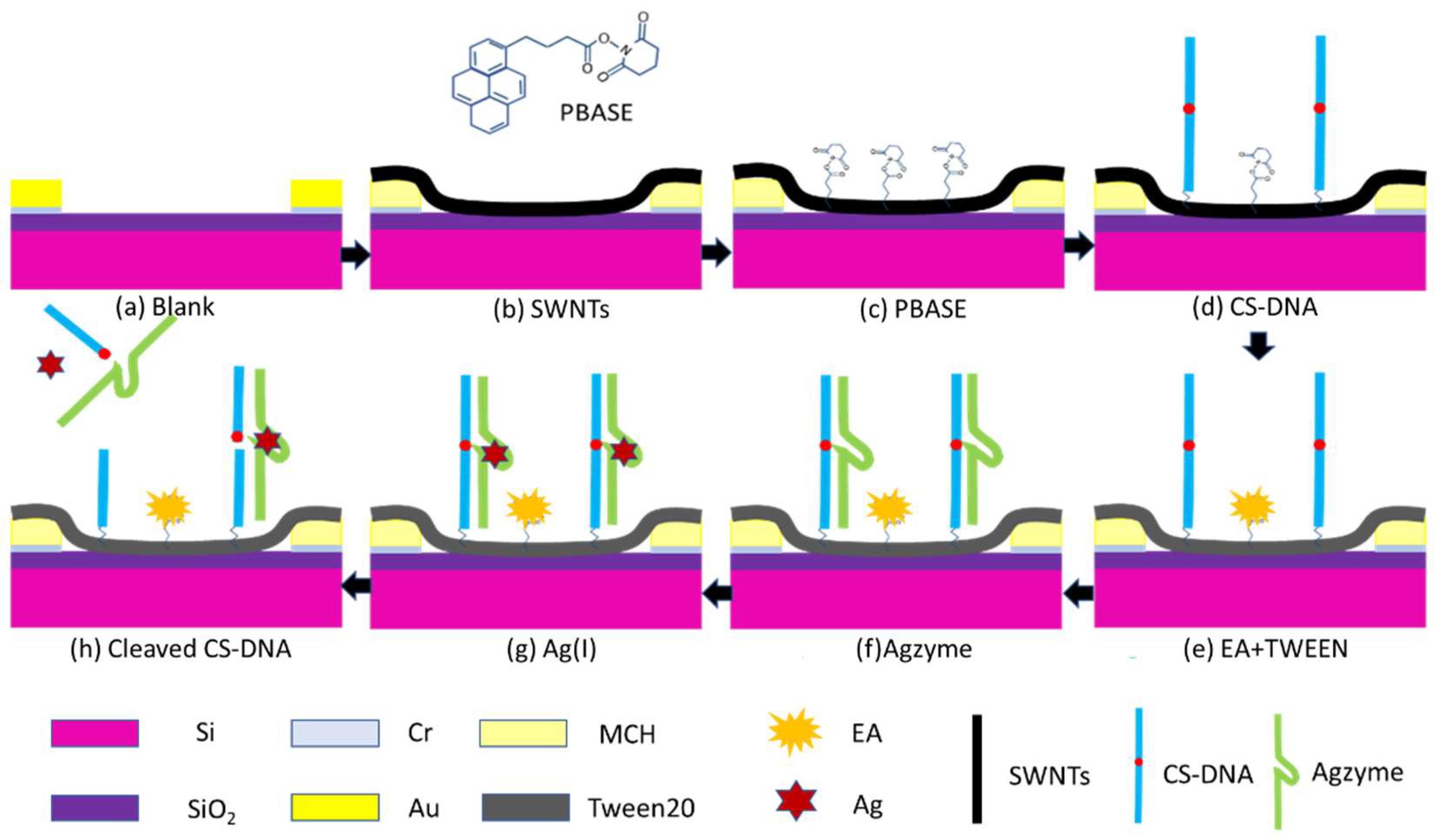
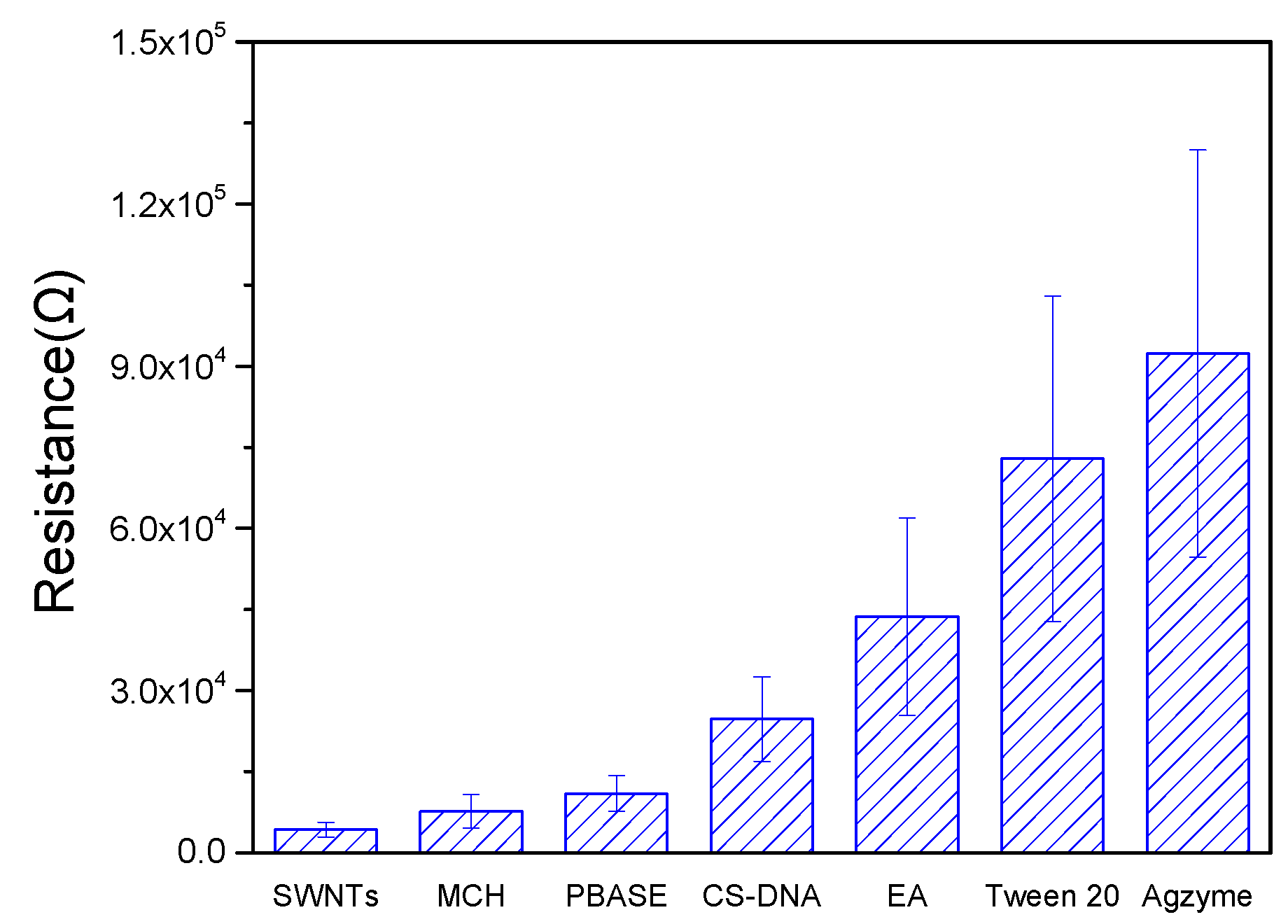
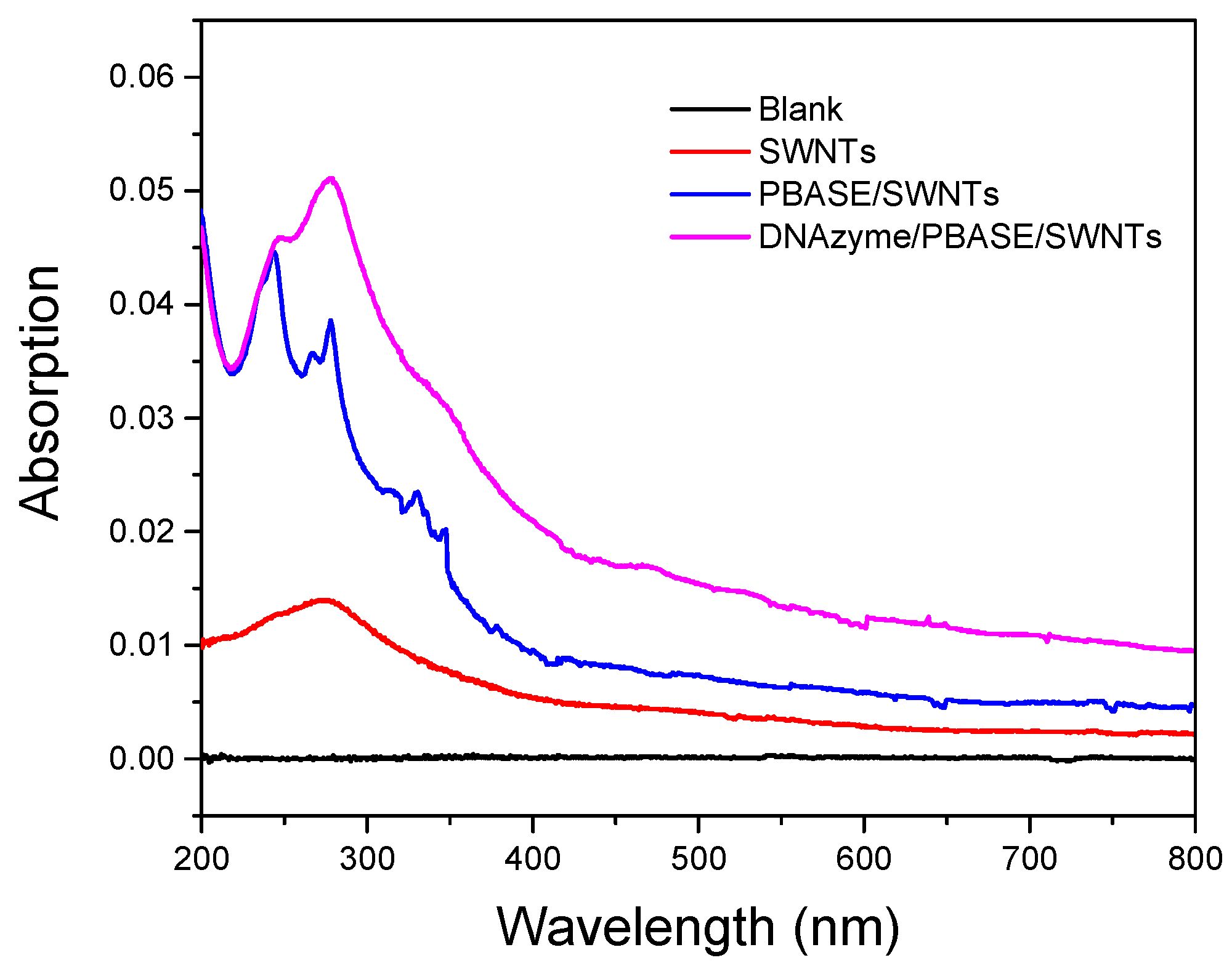
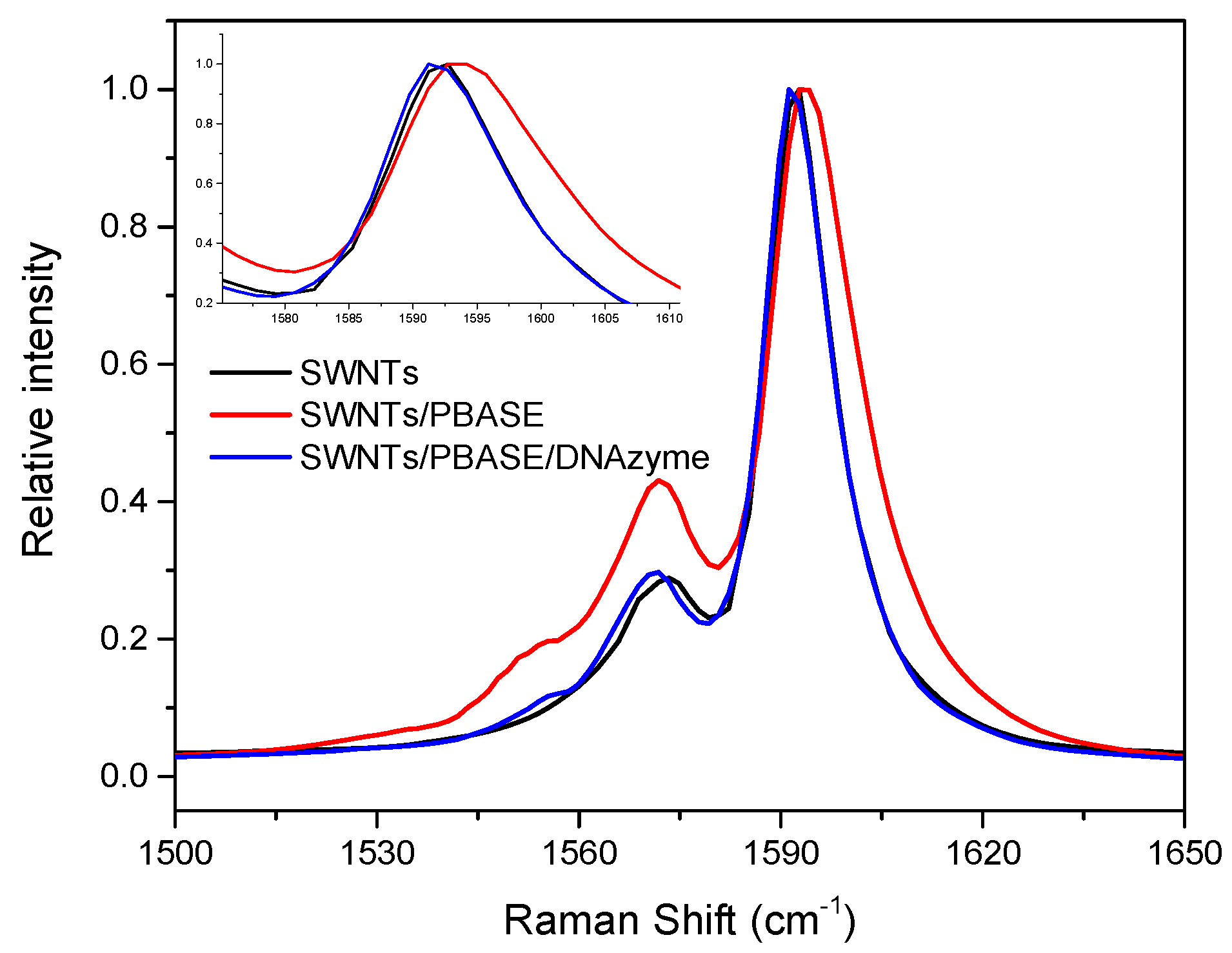
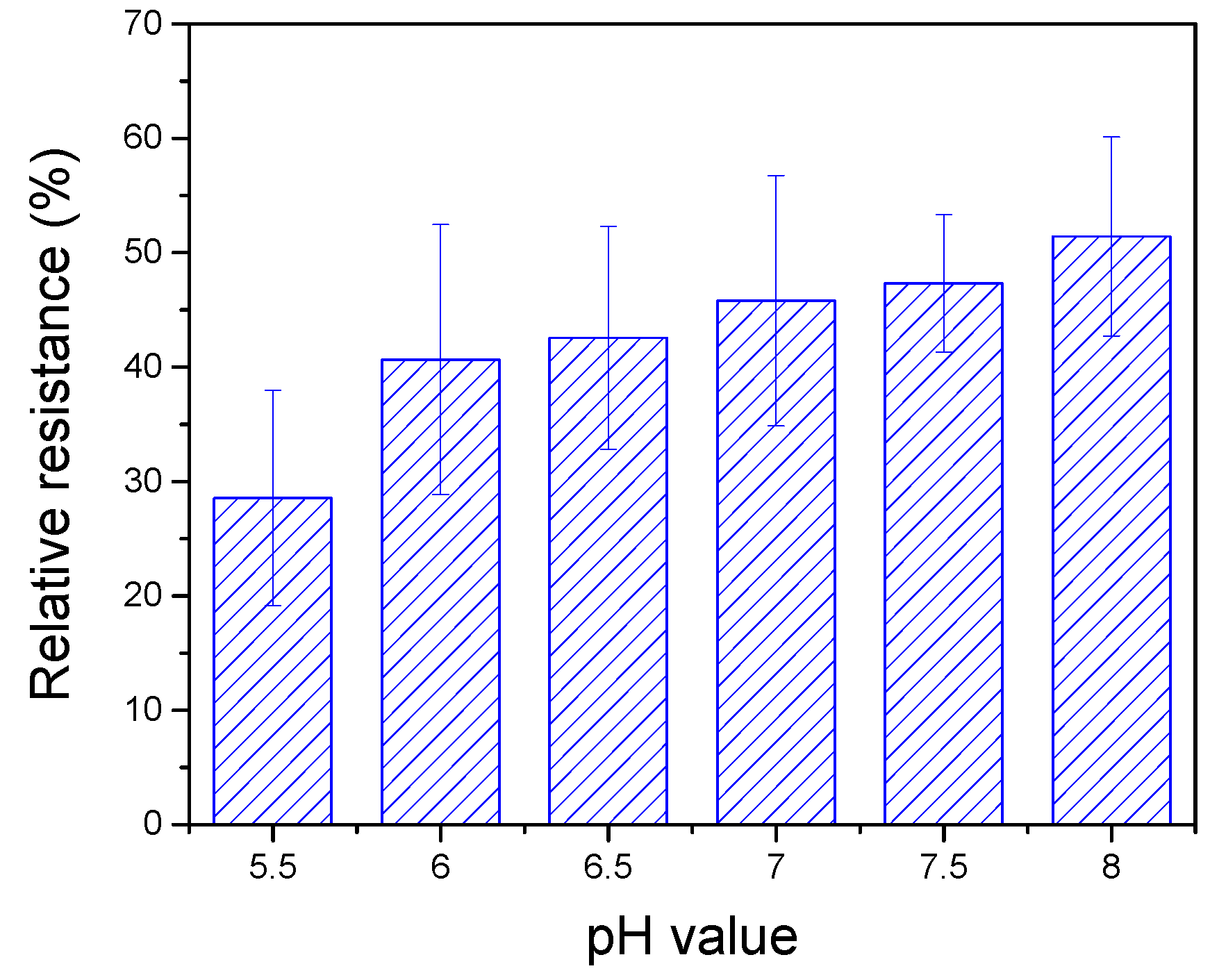
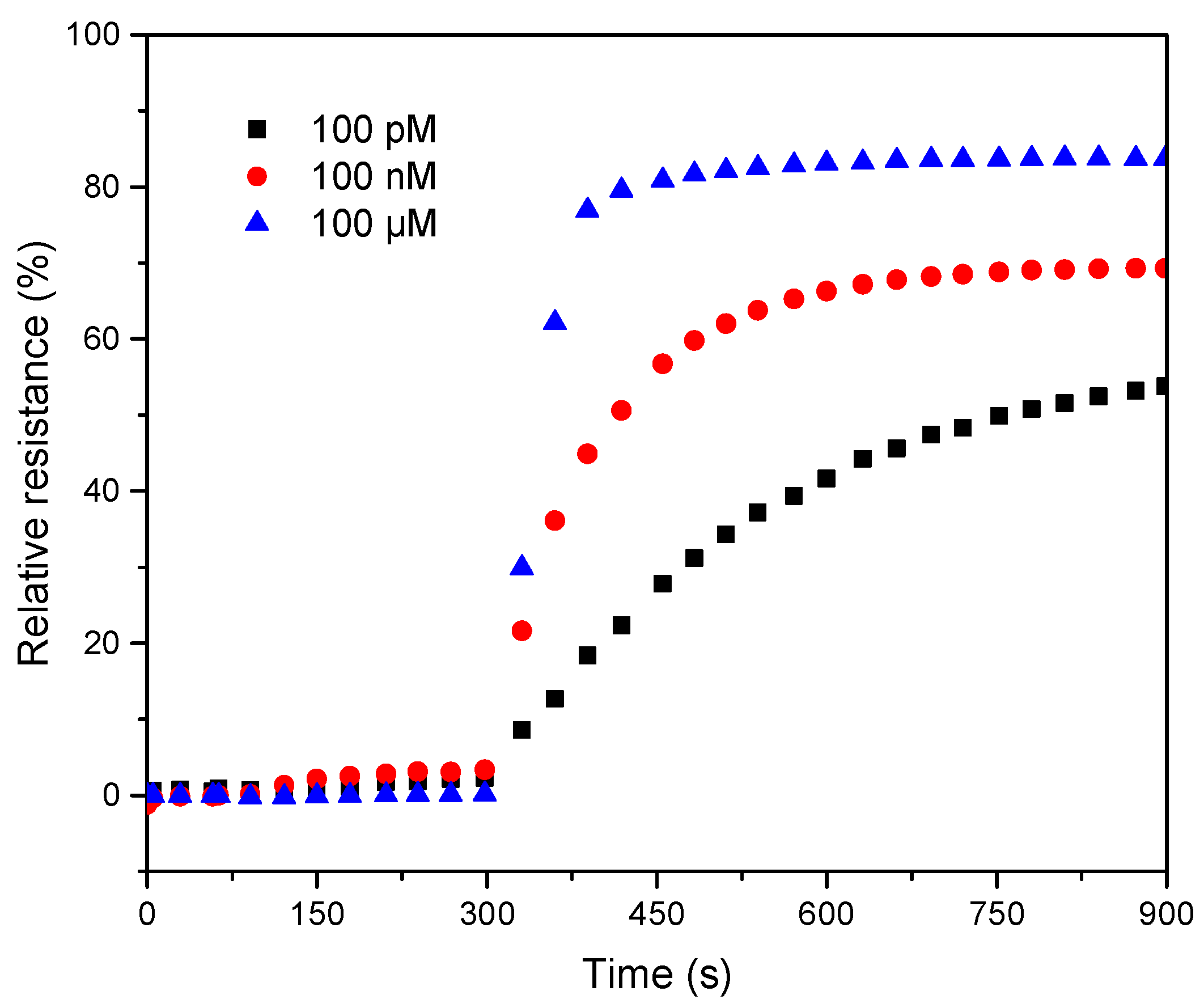
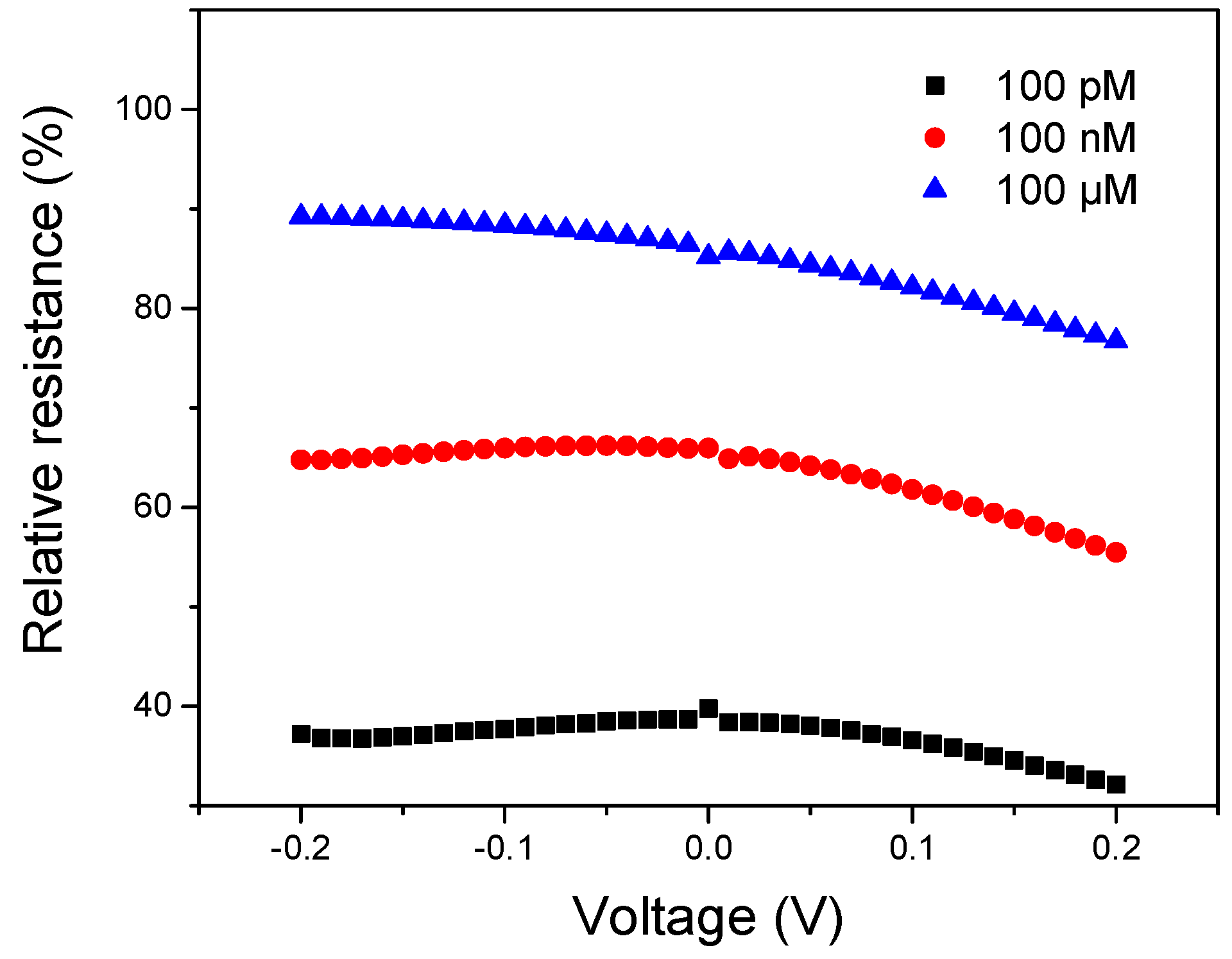

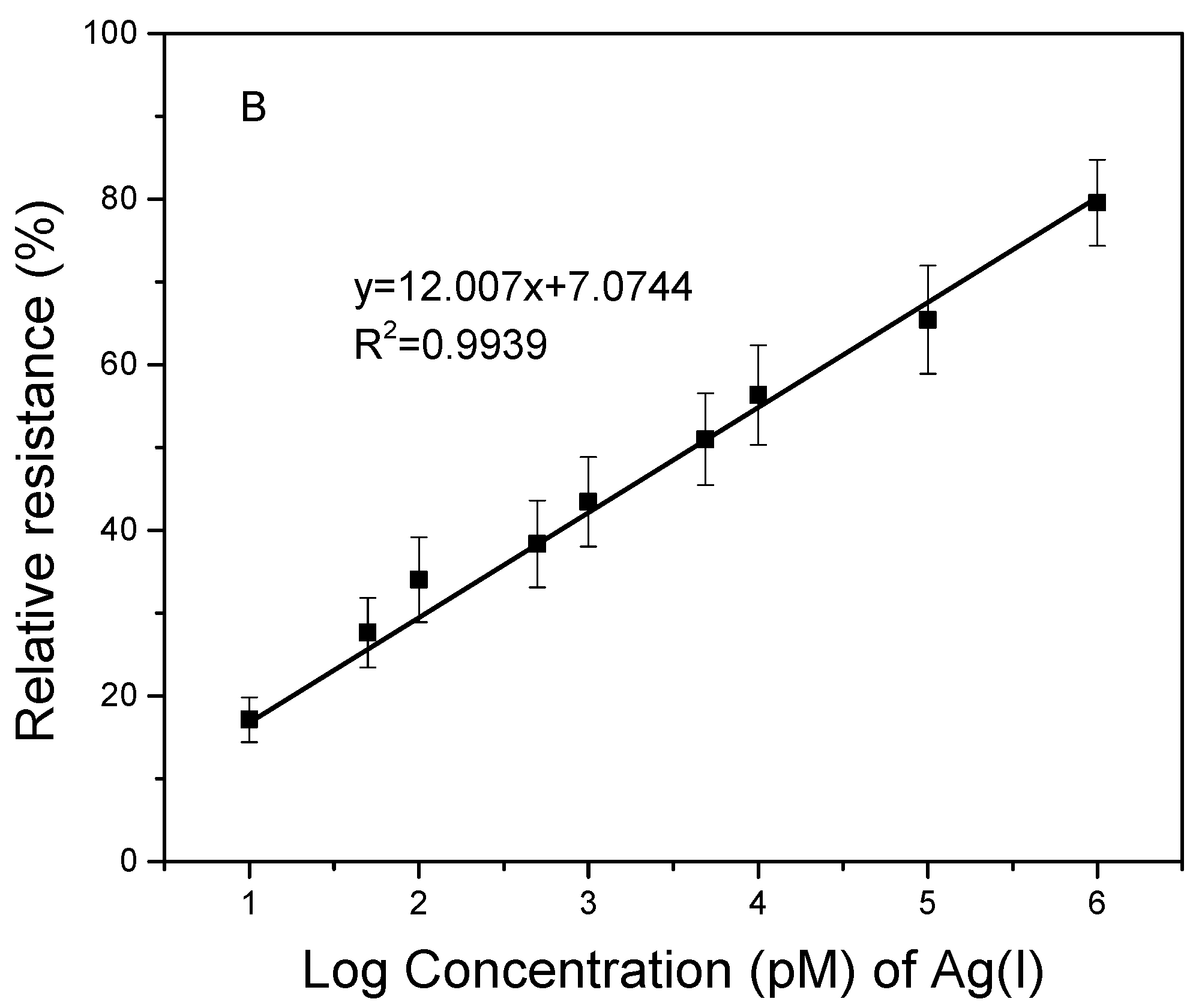
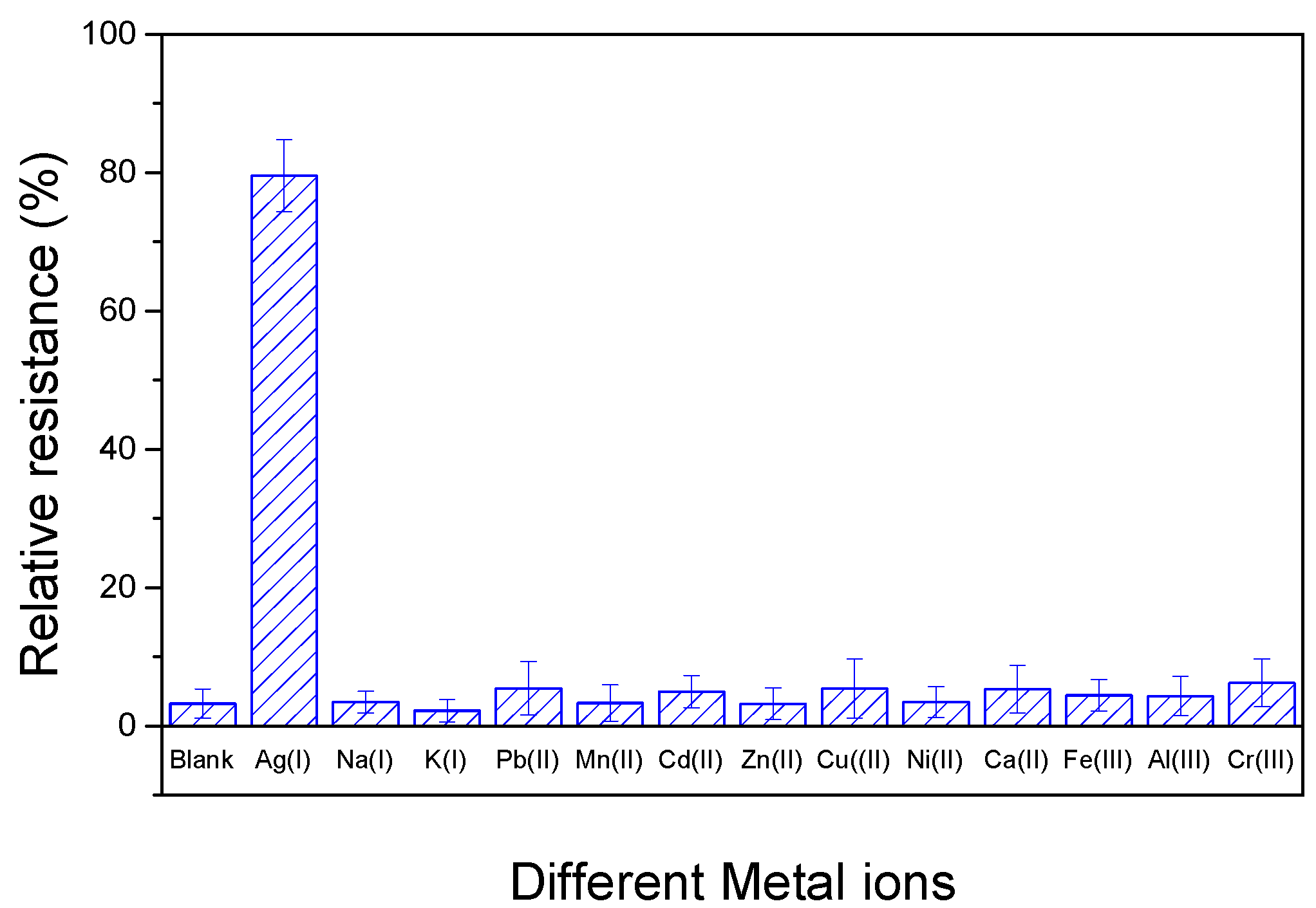
| Sensor | Method | Liner Ranges (M) | Determination Limits (M) | Reference |
|---|---|---|---|---|
| OND-Ag(I) | Fluorescence | 1.0 × 10−9~1.0 × 10−7 | 5.0 × 10−11 | [31] |
| G-Quadruplex-Hemin DNAzymes | UV-vis | 5.0 × 10−8~3.0 × 10−6 | 6.4 × 10−8 | [37] |
| RBITC-AuNP | Fluorescence | 1.0 × 10−8~7.0 × 10−7 | 4.8 × 10−10 | [38] |
| SGI/C-DNA | Fluorescence | 1.0 × 10−8~6.0 × 10−7 | 4.3 × 10−9 | [39] |
| CNP-OND | Fluorescence | 5.0 × 10−10~4.0 × 10−7 | 5.0 × 10−10 | [40] |
| QF-TAMRA | Fluorescence | 1.6 × 10−11~2.0 × 10−8 | 2.4 × 10−12 | [41] |
| DNA-MSS@AuNP | SERS | 1.0 × 10−8~1.0 × 10−6 | 1.0 × 10−9 | [42] |
| DNAyme/SWNTs/FET | IV | 1.0 × 10−11~1.0 × 10−6 | 5 × 10−12 | This work |
| Sample | Adding Ag(I) | DNAyme/SWNTs/FET | AAS | Recovery |
|---|---|---|---|---|
| nM | nM | nM | % | |
| 1 | - | 1.23 | 1.17 | 105.12 |
| 5 | 6.31 | 102.27 | ||
| 2 | - | 1.46 | 1.42 | 102.82 |
| 5 | 6.35 | 98.91 | ||
| 3 | - | 0.98 | 1.06 | 92.45 |
| 5 | 6.14 | 101.32 |
© 2018 by the authors. Licensee MDPI, Basel, Switzerland. This article is an open access article distributed under the terms and conditions of the Creative Commons Attribution (CC BY) license (http://creativecommons.org/licenses/by/4.0/).
Share and Cite
Wang, H.; Liu, Y.; Liu, G. Label-Free Biosensor Using a Silver Specific RNA-Cleaving DNAzyme Functionalized Single-Walled Carbon Nanotube for Silver Ion Determination. Nanomaterials 2018, 8, 258. https://doi.org/10.3390/nano8040258
Wang H, Liu Y, Liu G. Label-Free Biosensor Using a Silver Specific RNA-Cleaving DNAzyme Functionalized Single-Walled Carbon Nanotube for Silver Ion Determination. Nanomaterials. 2018; 8(4):258. https://doi.org/10.3390/nano8040258
Chicago/Turabian StyleWang, Hui, Yang Liu, and Gang Liu. 2018. "Label-Free Biosensor Using a Silver Specific RNA-Cleaving DNAzyme Functionalized Single-Walled Carbon Nanotube for Silver Ion Determination" Nanomaterials 8, no. 4: 258. https://doi.org/10.3390/nano8040258





